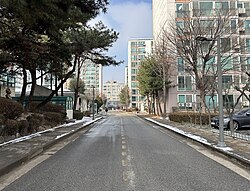|
Hometown Village
Hometown Village (Korean: 고향마을; Hanja: 故鄕마을; RR: Gohyang Maeul; Russian: Кохян Маыль) is a community of eight apartment buildings and enclave of Sakhalin Koreans at 39 Yonghagongwon-ro, Sangnok-gu, Ansan, South Korea.[1][2] It is the largest enclave of Sakhalin Koreans in the country.[3] The community is composed of members of the return migration of the Korean diaspora. Settlement in the community began in 2000. The current population is primarily elderly, and was 764 by October 2023.[4] BackgroundSakhalin Koreans are an ethnic group primarily based on the island of Sakhalin in Russia. They descend from populations of Koreans that were forced to move and labor under difficult conditions there during the Japanese colonial period, when the island was under Japanese control (then Karafuto Prefecture).[5][3] After the end of the colonial period, the island was taken by the Soviet Union. The USSR allowed for the repatriation of Sakhalin Koreans to communist North Korea, but those who were from the South found themselves behind the Asian Iron Curtain. Moreover, the Soviet government was not keen on returning the Koreans home, as the Sakhalin island needed a labor force. The Koreans were permitted to apply for Soviet citizenship, but many refused, wanting to go back to their homeland.[5][1] Many first-generation Sakhalin Koreans maintained the hope for decades that they could eventually be allowed to return.[5] After the fall of the Soviet Union in the early 1990s, South Korea and Russia established diplomatic ties, and began offering Sakhalin Koreans the opportunity to move to South Korea.[5] In 1993, South Korea and Japan negotiated the construction of an apartment complex for the returnees.[6] The government of Japan contributed 3.2 billion yen for the repatriation as reparations for the forced labor.[1][3] In the 1990s and 2000s, more than 4,000 first-generation Sakhalin Koreans moved to South Korea. By this point, they were elderly and wished to die in their homeland. On the other hand, many non–first-generation Koreans wished to stay in Russia, as they had assimilated there.[5] The returnees often left family and friends behind in Sakhalin, which led to tearful goodbyes.[5] In 2021, South Korea began allowing direct descendants of first-generation Sakhalin Koreans and their spouses to settle in South Korea. Their move is often motivated by economic factors, as they seek work in the country.[1] Description As the returnees to South Korea were mostly elderly, accommodations needed to be prepared that provided the function of nursing homes or retirement communities.[1] Residents began moving into the complex in February 2000.[7] The population peaked at 980 in 2000, with an average age of 78.6. Since then, the population has gradually decreased as residents have died.[3]  Housing was provided on a 50-year public lease[7] free-of-charge, and support systems were developed to help navigate South Korean society.[1] The residents are given a pension, and are responsible for paying for utilities and groceries.[3] In 2023, one resident stated that lunch was offered for free in the community center.[8] Healthcare is readily available, with services provided by the South Korean and Japanese Red Cross.[1] Classes are held on how to manage various common medical conditions.[3] Korean language classes are offered.[9] By 2022, there were around 770[7] residents in eight different apartment buildings, each ten stories.[3][1] Various community activities and facilities are available. There is a local choir and dance group that have performed for the general public.[10] There are spaces for playing mahjong, the Russian tile game lotto, table tennis, and for karaoke.[1] The enclave is the subject of Episode 497 of the podcast 99% Invisible.[1] Points of dissatisfactionWhile many returnees are grateful for the opportunity they were given to return and receive these services, there are still some points of dissatisfaction.[9][11] Many residents only speak Russian or speak dialects that are not easily understood by modern South Koreans, which has led to difficulty with integration.[11] Some find the experience bittersweet, knowing that by the time the repatriation occurred (beginning around 50 years after Korea was liberated in 1945), many first-generation Sakhalin Koreans had died without ever seeing their homeland again.[11] The separation between residents and those who remain back in Sakhalin has caused emotional stress,[11][9] which was intensified by travel restrictions during the COVID-19 pandemic.[5] Some older residents live alone, which has led to feelings of isolation.[9][3] While relatives can fly to South Korea to visit, this process is considered too expensive to afford to do frequently.[9] As of 2023[update], South Korea only allows one direct descendant and their nuclear family to move to South Korea, which has led to separated families.[9] Furthermore, descendants who return in this manner are not allowed to work, as they receive a pension from the government. This has also been a point of contention.[9] See also
References
External linksWikimedia Commons has media related to Hometown Village.
|
||||||||||||||||||||||||||||

